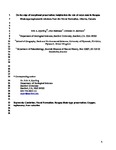On the edge of exceptional preservation: insights into the role of redox state in Burgess Shale-type taphonomic windows from the Mural Formation, Alberta, Canada
| dc.contributor.author | Sperling, EA | |
| dc.contributor.author | Balthasar, U | |
| dc.contributor.author | Skovsted, CB | |
| dc.date.accessioned | 2018-05-30T11:57:08Z | |
| dc.date.issued | 2018-09 | |
| dc.identifier.issn | 2397-8554 | |
| dc.identifier.issn | 2397-8562 | |
| dc.identifier.uri | http://hdl.handle.net/10026.1/11604 | |
| dc.description.abstract |
<jats:p>Animals originated in the Neoproterozoic and ‘exploded’ into the fossil record in the Cambrian. The Cambrian also represents a high point in the animal fossil record for the preservation of soft tissues that are normally degraded. Specifically, fossils from Burgess Shale-type (BST) preservational windows give paleontologists an unparalleled view into early animal evolution. Why this time interval hosts such exceptional preservation, and why this preservational window declines in the early Paleozoic, have been long-standing questions. Anoxic conditions have been hypothesized to play a role in BST preservation, but recent geochemical investigations of these deposits have reached contradictory results with respect to the redox state of overlying bottom waters. Here, we report a multi-proxy geochemical study of the Lower Cambrian Mural Formation, Alberta, Canada. At the type section, the Mural Formation preserves rare recalcitrant organic tissues in shales that were deposited near storm wave base (a Tier 3 deposit; the worst level of soft-tissue preservation). The geochemical signature of this section shows little to no evidence of anoxic conditions, in contrast with published multi-proxy studies of more celebrated Tier 1 and 2 deposits. These data help confirm that ‘decay-limited’ BST biotas were deposited in more oxygenated conditions, and support a role for anoxic conditions in BST preservation. Finally, we discuss the role of iron reduction in BST preservation, including the formation of iron-rich clays and inducement of sealing seafloor carbonate cements. As oceans and sediment columns became more oxygenated and more sulfidic through the early Paleozoic, these geochemical changes may have helped close the BST taphonomic window.</jats:p> | |
| dc.format.extent | 311-323 | |
| dc.format.medium | ||
| dc.language | en | |
| dc.language.iso | en | |
| dc.publisher | Portland Press Ltd. | |
| dc.subject | Burgess Shale-type preservation | |
| dc.subject | Cambrian | |
| dc.subject | Mural Formation | |
| dc.subject | iron reduction | |
| dc.subject | oxygen | |
| dc.subject | taphonomy | |
| dc.title | On the edge of exceptional preservation: insights into the role of redox state in Burgess Shale-type taphonomic windows from the Mural Formation, Alberta, Canada | |
| dc.type | journal-article | |
| dc.type | Journal Article | |
| plymouth.author-url | https://www.ncbi.nlm.nih.gov/pubmed/32412614 | |
| plymouth.issue | 2 | |
| plymouth.volume | 2 | |
| plymouth.publication-status | Published | |
| plymouth.journal | Emerging Topics in Life Sciences | |
| dc.identifier.doi | 10.1042/ETLS20170163 | |
| plymouth.organisational-group | /Plymouth | |
| plymouth.organisational-group | /Plymouth/Faculty of Science and Engineering | |
| plymouth.organisational-group | /Plymouth/Faculty of Science and Engineering/School of Geography, Earth and Environmental Sciences | |
| plymouth.organisational-group | /Plymouth/REF 2021 Researchers by UoA | |
| plymouth.organisational-group | /Plymouth/REF 2021 Researchers by UoA/UoA07 Earth Systems and Environmental Sciences | |
| plymouth.organisational-group | /Plymouth/Users by role | |
| plymouth.organisational-group | /Plymouth/Users by role/Academics | |
| dc.publisher.place | England | |
| dcterms.dateAccepted | 2018-05-25 | |
| dc.rights.embargodate | 2019-7-26 | |
| dc.identifier.eissn | 2397-8562 | |
| dc.rights.embargoperiod | 12 months | |
| rioxxterms.versionofrecord | 10.1042/ETLS20170163 | |
| rioxxterms.licenseref.uri | http://www.rioxx.net/licenses/under-embargo-all-rights-reserved | |
| rioxxterms.licenseref.startdate | 2018-09 | |
| rioxxterms.type | Journal Article/Review |


